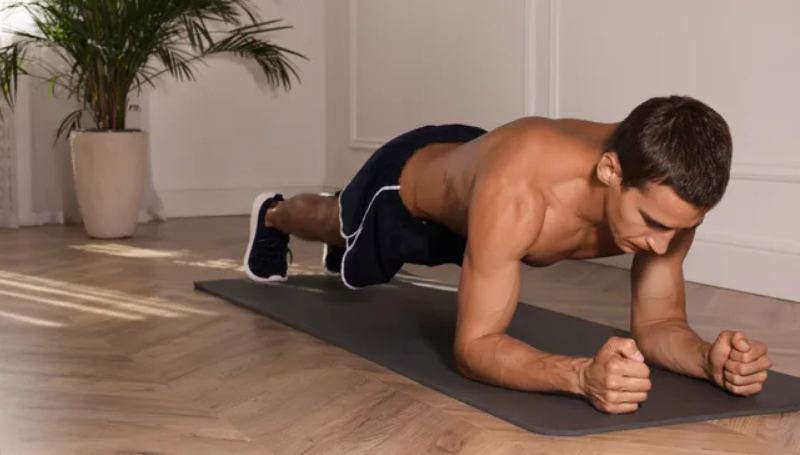Discover the fitness revelation you never knew you needed: the RKC plank, also known as the Russian plank. Little did I realize the significance of this plank variation until I delved into a week-long challenge, and let me tell you, it’s not for the faint of heart.
Unlike typical plank challenges that focus on the number of reps, the RKC plank challenge revolves around the duration of the hold. Throughout the week, I accumulated an impressive 10 minutes of RKC planks each day, bypassing the conventional approach of counting reps but embracing the intensity of the hold.
The name itself, RKC, stands for Russian Kettlebell Challenge, attributed to its inventors. This plank variation stands out as one of the most potent and impactful exercises for your core. The key lies in intensifying the hold beyond the standard plank, promising a quicker activation of muscles and a more robust core.
If you’re ready to elevate your plank game, consider securing one of the top-notch yoga mats to support your limbs during this challenge. The journey into the world of RKC planks promises not only to test your endurance but also to sculpt a stronger core and engage multiple muscle groups in a remarkably condensed timeframe. The pain may be real, but the results are undeniable. Step up to the challenge and witness the transformation for yourself.
How to do RKC planks
The RKC plank, distinguished by its isometric contraction technique, takes your core workout to a whole new level by emphasizing the art of squeezing without flexing or extending muscles. In this challenging variation, the goal is to engage as many muscles as possible with intensity, making surpassing the 20-30 second mark a noteworthy feat.
Executing the RKC plank involves a meticulous focus on specific muscle groups. Here’s your checklist for mastering this demanding variation:
- Form Matters: Begin in a forearm plank position with elbows directly beneath shoulders, and ensure your armpits and toes are tucked under. Maintain a straight line from your head to your toes without allowing your hips to sag.
- Shoulder Engagement: Screw your shoulder blades back and down while tightly squeezing your fists.
- External Shoulder Rotation: Execute an external rotation of your shoulders to enhance muscle engagement.
- Lower Body Activation: Start by squeezing your glutes, then your quads. Contract your legs and bring your feet together.
- Elbow-Toe Interaction: Intensify the squeeze by dragging your elbows toward your toes and simultaneously pulling your toes toward your elbows, creating a movement akin to a pike.
- Full Body Tuck: Imagine an upside-down hollow hold, tucking everything under and generating a subtle rounding in your upper back.
This rigorous variation may resemble a typical forearm plank, but the magic lies in the intricate dance of contracting and squeezing multiple muscles simultaneously—without any actual movement. As you progress, you’ll notice a shift in your hand position, transitioning from parallel to fists turned inward. Embrace the challenge, perfect your form, and witness the transformative power of the RKC plank as it targets and activates muscles like never before.
I did 10-minute RKC planks every day for a week – here’s what happened to my core
Here’s how it went.
DAY 1
The RKC plank proves itself to be a formidable challenge, surpassing the difficulty of the standard forearm plank and offering substantial benefits in a remarkably condensed timeframe. To put it to the test, I adopted a 20-second on and 10-second off format, completing an impressive 20 rounds for a total of 10 minutes.
The key to conquering this demanding exercise lies in meticulous adherence to the ‘squeezing checklist’—a systematic approach to engaging specific muscle groups. Limb by limb, I set up my position and diligently ran through the checklist, ensuring each element was addressed. The result was a workout that pushed the boundaries, not only in terms of endurance but also in terms of maintaining corrective form and posture.
Considering my experience with a daily regimen of 90 commando planks for an entire week, the RKC plank emerged as the toughest plank challenge to date. Its intensity, combined with the focus on form and posture correction, created a workout that not only tested physical limits but also provided a more efficient and effective way to strengthen the core. The payoff of this challenge is undeniably significant, offering a higher return on investment in a shorter time span.
DAY 2 AND 3
Engaging in my regular training routine, I decided to incorporate a 10-minute session of RKC (Russian) planks on day one. The aftermath was a sensation that reverberated throughout my entire body, with a particular emphasis on my core—a reaction not entirely unexpected. The crux of this intense exercise lies in strategic squeeze checkpoints, involving the clenching of fists, external rotation of the shoulders, and a thorough squeeze of the quads and glutes, while simultaneously contracting the legs and bringing the feet together.
Within the first 10 minutes of the RKC plank, every inch of my body seemed to be awakened, creating a comprehensive yet focused workout experience. Once in the plank position, the emphasis shifts to pulling the toes and elbows toward each other, mimicking a plank pike. This subtle movement places a significant demand on the deeper core muscles, intensifying the overall workout.
Despite the absence of physical movement, the RKC plank activates major muscle groups including the shoulders, chest, back, arms, core, lower back, glutes, and quads. The beauty of this exercise lies in its ability to stimulate smaller, often overlooked stabilizing muscles. The 10-minute RKC plank proved to be a holistic challenge, offering a comprehensive workout that not only targets primary muscle groups but also taps into those essential stabilizers that are frequently neglected in traditional training.
DAY 4 AND 5
As I progressed to day four of the RKC plank challenge, the cumulative effort of maintaining constant engagement, particularly in my shoulders, began to take its toll. Fatigue set in, and I found it increasingly challenging to uphold impeccable form without compromising elsewhere. Tuning into my upper body often led to a drop in my hips, while focusing on my lower body caused my tightly clenched fists to unfurl.
It’s crucial to note that the RKC plank experience diverges significantly from a conventional plank hold. This distinction underscores the importance of running through the checklist regularly to reactivate areas that might otherwise switch off. One notable observation was the heightened activation of my glutes, a region I typically struggle to engage in various exercises.
The intensified effort in the RKC plank also brought attention to the impact on breathing. The additional strain made breathing feel more stilted, prompting me to concentrate on deepening my breath. Embracing diaphragmatic breathing, commonly known as “belly breathing,” proved crucial in maintaining a more expansive breath pattern compared to the restricted chest breathing.
A mindful approach to breathing involved drawing in my stomach on every exhale while simultaneously driving my elbows and toes together. By day five, the concerted effort paid off, with my core muscles well and truly ignited. The nuanced challenges of the RKC plank not only pushed my physical limits but also heightened my awareness of form, breathing, and muscle engagement, resulting in a comprehensive and transformative workout experience.
DAY 6 AND 7
Approaching day six of the RKC plank challenge, a sense of rhythm finally began to emerge, and the conscious contraction, though still demanding, felt more natural. Seeking to gauge my core strength, I opted to deviate from the structured format for the remaining days. Instead, I aimed for maximum holds each time, accumulating a total of 10 minutes over the course of the session.
While the hold times understandably shortened as fatigue set in, I managed to maintain a commendable level of consistency. As day seven arrived, a mix of relief and accomplishment washed over me, signaling the end of the challenge. Despite the undeniable difficulty, it was apparent that my plank game had been significantly elevated throughout the process.
In summary, the verdict on the RKC plank challenge is clear. The 20-second intervals feel substantially longer due to heightened muscle activation, contributing to improvements in abdominal strength, posture, and the activation of a broader spectrum of muscle groups. The exercise not only builds endurance efficiently by generating maximum tension in the body but also demands significant engagement from both external and internal core muscles, evident in the requirement to pull elbows and toes toward each other.
The benefits extend beyond the immediate challenge, as enhanced core strength plays a pivotal role in weightlifting exercises such as deadlifts and squats. Strengthening the muscles in the back that support the spine not only contributes to improved posture but also serves as a protective measure against injury. For those considering the RKC plank, a prudent starting point is 10-20 second sets for five repetitions, progressively increasing as proficiency improves. The challenge is demanding, but the rewards in terms of core strength and overall muscle activation make it a worthwhile addition to any fitness regimen.





